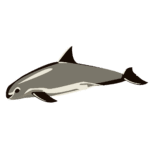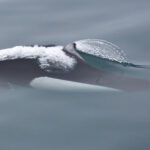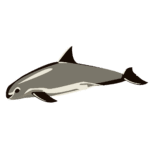Meet the Vaquita, the world’s smallest and most endangered cetacean species! It’s 4.5-5 feet long and weighs around 120 pounds. It has a dark-colored back, light gray sides, and a white belly which help it blend in with its surroundings.
Its most remarkable feature? Its ability to communicate using echolocation! It sends out high-frequency clicks and listens for echoes to help navigate, find food, and detect potential threats.
Sadly, there are only around 10 Vaquitas left. We must act fast to save them from extinction. Raising awareness and supporting conservation efforts are key.
Let’s make a difference and ensure future generations can witness the beauty of this unique marine animal. Why settle for dolphins when you can have a Vaquita? Let’s get to work and give them a fighting chance!
Key Takeaways
- The vaquita is a small porpoise species found only in the Gulf of California, Mexico.
- Vaquitas are known for their distinctive black patches around their eyes and lips, as well as their small size, reaching up to 5 feet in length.
- These porpoises have a unique adaptation called a “phonic lip,” which allows them to produce high-frequency sounds for communication and echolocation.
- Vaquitas primarily feed on small fish and squid, using their sharp teeth to catch their prey.
- Unfortunately, vaquitas are critically endangered, with only an estimated 10 individuals remaining in the wild as of 2021.
- The main threat to vaquitas is accidental entanglement in fishing nets, particularly those used for illegal fishing of the totoaba fish.
- Conservation efforts are being made to protect the vaquita, including the establishment of a protected area and the implementation of fishing restrictions.
- International cooperation and awareness are crucial in saving the vaquita from extinction.
Physical Description

The vaquita, also known as the Gulf of California porpoise, is a small cetacean species found only in the northern part of the Gulf of California. It’s one of the world’s smallest and most elusive marine mammals!
It has a unique appearance, with a robust body and a dark black “smile” marking around its mouth. Its size ranges from 4.6 to 5 feet, and it usually weighs between 90 to 120 pounds. It has a dark grayish color on its dorsal side and a lighter gray shade on its ventral side, which helps it to blend in with its surroundings.
The vaquita stands out from other marine mammals in a few ways. Unlike most dolphins, it lacks a prominent beak and has a small, rounded head. Its relatively large flippers also help it swim through the turbid waters of its habitat.
Despite its small size, the vaquita is quite agile and can swim swiftly in both shallow coastal waters and deeper parts of the Gulf. It feeds on fish, squid, and crustaceans.
Remember to keep your distance if you ever encounter a vaquita in the wild. It’s important to prioritize their conservation and support efforts to protect their habitat and reduce human activities that threaten their survival.
Habitat and Distribution
Vaquitas are small marine mammals native to the Gulf of California. They prefer shallow, murky waters near the shoreline. This restricts their range and distribution, as seen in the following table:
| Location | Habitat | Distribution |
|---|---|---|
| Gulf of California | Shallow, murky waters near shoreline | Restricted to upper Gulf |
Vaquitas live close to the shoreline in the coastal zone. Unfortunately, illegal fishing practices and habitat degradation have led to a drastic decrease in their population. They are now listed as one of the most critically endangered species.
Organizations and governments worldwide have implemented initiatives to protect vaquitas. These include strict fishing regulations and conservation programs to restore their habitat. We must continue our collective efforts to ensure the survival of these remarkable creatures.
Feeding Habits
Vaquitas possess unique feeding habits. They use echolocation to locate small fish and squid, resulting in a diet of various species like croaker fish and squid. They dive up to 150 meters to hunt and feed during both day and night, using their sharp teeth to capture and eat their prey. Vaquitas are selective feeders and prefer certain types of fish.
Their impressive hunting skills are due to their highly developed echolocation system, which allows them to navigate murky waters and find food sources precisely. Conservation efforts for vaquitas are essential, due to their critically endangered status. Only a few dozen exist in the wild.
We must raise awareness of their plight and support organizations striving to conserve them. By working together, we can make a difference and guarantee their survival for future generations. Furthermore, males use their best undersea magician skills to elude detection when reproducing.
Reproduction and Life Cycle
The vaquita, a small porpoise species, has an intriguing reproduction and life cycle. At 3-6 years of age, these marine mammals become sexually mature. To attract a female, males exhibit behaviors such as leaping out of the water or making chattering sounds underwater.
Once pregnant, females carry their calves for 10-11 months. Calving usually occurs between March and May in shallow waters. At birth, the newborn measures 70 cm and weighs approximately 20 kg. Maternal instincts of vaquitas are strong; they nurture and care for their offspring until independence.
An interesting trait of vaquitas is their slow reproductive rate. Every two years, they give birth to one calf – which makes them vulnerable to declining population numbers. Sadly, only around 10 individuals remain in the wild. Urgent conservation efforts are necessary to save them from extinction.
Let’s raise awareness about the vaquita’s critical situation. By supporting conservation initiatives and raising attention for these remarkable creatures, we can help prevent them from disappearing forever. Every action counts! Let’s act now before it’s too late!
Threats and Conservation Status

The vaquita is in trouble. Illegal fishing, habitat destruction, and climate change all threaten its survival. Conservation programs and fishing regulations are trying to help. But there’s more. Pollution from farming and increased shipping make things worse. We must act fast to save this unique porpoise.
A dedicated team of researchers is fighting to raise awareness. They got money for conservation and work with local communities. They don’t give up – their perseverance gives hope. But saving the vaquita is hard – it seems like it’s playing hide and seek with a ghost!
Current Efforts to Protect the Vaquita
Efforts to save the Vaquita are ongoing. Scientists and conservationists are working hard to protect this endangered species. Its population is rapidly decreasing, so urgent action is needed. Key initiatives include creating protected areas in the vaquita’s habitat and enforcing regulations to stop illegal fishing. International collaborations have been formed between countries like Mexico and the US to fight the issue at a global level. Research teams are also learning more about the vaquita’s biology and behavior, which can help inform conservation efforts. Despite all these efforts, time is running out for the vaquita. There are only a few dozen individuals left, so people must become aware of this crisis and support organizations protecting marine life. Donations can make a difference in saving the vaquita from extinction. We must act quickly before it’s too late. Join the fight and make a brighter future for the vaquita together. Don’t miss this chance – the time to act is now!
Frequently Asked Questions
1. What is the size of a vaquita?
The vaquita is one of the smallest cetaceans, measuring around 4 to 5 feet in length and weighing between 90 to 120 pounds.
2. Where can vaquitas be found?
Vaquitas are found exclusively in the Gulf of California, also known as the Sea of Cortez, in Mexico.
3. What is the vaquita’s main characteristic?
The vaquita is known for its distinctive dark rings around its eyes and dark patches on its lips. It also has a small, rounded dorsal fin.
4. How many vaquitas are left in the wild?
There are currently less than 15 vaquitas left in the wild, making it the most endangered marine mammal in the world.
5. What do vaquitas eat?
Vaquitas primarily feed on small fish, squid, and crustaceans found in the shallow waters of the Gulf of California.
6. How long do vaquitas live?
Vaquitas have an estimated lifespan of up to 20 years in the wild, although not enough research has been conducted to determine their exact lifespan.
Conclusion
The vaquita is a small, unique porpoise. It’s shy and rarely seen, making it tough to study. But researchers know enough to say it’s critically endangered.
They have dark rings around their eyes and lips. They’re stocky and can reach five feet long and 120 pounds. Small size helps them swim in shallow water in Mexico’s Gulf of California.
They eat fish, squid, and crustaceans. Echolocation helps them find food. They also communicate through sounds, clicks, and whistles.
Sadly, vaquitas are near extinction. Illegal fishing practices, especially for the totoaba, trap and drown them.
Sea Shepherd is a conservation team that tried to save them. Despite challenges, they patrolled the Gulf of California and removed illegal nets from vaquita habitats.
References





